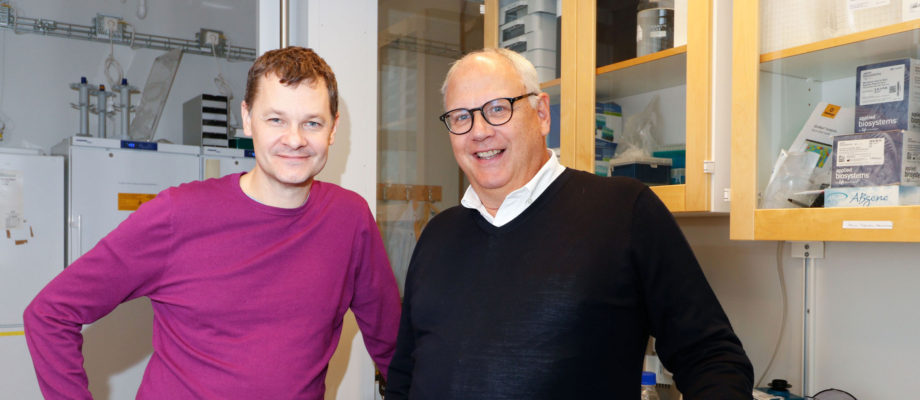LEADERSHIP ASSIGNMENT. Since 2010 the Sahlgrenska Cancer Center has mobilized resources for cancer research in Gothenburg – an initiative that has paved the way for more research funding and the recruiting of top researchers. Jonas Nilsson has now succeeded Göran Stenman as director of the center.
Nilsson heads a translational research collaboration on malignant melanoma, which focuses on a highly advanced animal model called PDX mice. He regards his appointment as director of the Sahlgrenska Cancer Center (SCC) as an important assignment and notes that a prerequisite for him to accept the position was the fact that it also would continue to be closely associated with the center’s research activities.
“The Sahlgrenska Cancer Center is already an important hub within cancer research, but we cannot rest on our laurels. We want to continue to develop and challenge research and researchers,” says Nilsson.
Cramped premises
Sahlgrenska Cancer Center has expanded rapidly, already outgrowing its premises.
“I will not hide the fact that I wish Sahlgrenska Life had been built yesterday. Since we do not know exactly when this will happen, I need to talk with senior people at Sahlgrenska Academy and Sahlgrenska University Hospital and explain that we probably have the highest density of people in the entire faculty. Although the original understanding was that we would share premises, it can’t go too far, because this could seriously hamper our operations and the expansion of research teams.”
The construction of Naturvetenskap Life will soon begin very near the Sahlgrenska Cancer Center. What do you think of that?

“I’m not concerned about it. In the working teams I have been part of, we have received assurances that our operations will not be affected as much as you might expect when a mountain is being demolished. Many reliable people are working hard to ensure there will be as little impact as possible, and no construction lasts forever,” Nilsson says, adding that he believes the new neighboring building can produce many good synergies for SCC’s operations:
“The time is too far off now, but I would, of course, be very happy if the person responsible for the cancer strategic research domain at the University of Gothenburg were invited to discuss collaboration and possible extra premises adjacent to SCC.”
A strategic research domain
Sahlgrenska Cancer Center (SCC) was formed in 2010 after cancer researchers in Gothenburg, together with colleagues at Lund University, were awarded one of the research programs (BioCARE) that the Swedish government had announced as strategic initiatives. These funds, combined with co-financing from the vice-chancellor, became the basis for the establishment of SCC. At the same time, cancer was designated a strategic research domain at the University of Gothenburg. From its inception until the middle of this year, Göran Stenman served as SCC director.
“The investment in the cancer center has meant that we have been able to offer an attractive research environment that made it possible to recruit a number of top researchers in the cancer field,” Stenman says. “Jonas Nilsson, who now takes over as director, is an example of this.”
The establishment of SCC has clearly improved the conditions for cancer research in Gothenburg, Stenman maintains. A clear sign of this is that grants from the Swedish Cancer Society have increased sharply; in recent years a significantly higher share of funding from the society has come to cancer researchers in Gothenburg, who have received both more and larger grants than before.
“Three years after SCC’s establishment, the Swedish Cancer Society made an on-site visit here, and we got top marks in the evaluation,” Stenman says proudly.
New biomarkers and target molecules
The establishment of SCC has also had a very positive effect on our research results:
“Our researchers have made a series of important and in some cases groundbreaking discoveries that, in a fairly short time, have benefited cancer patients. They include new biomarkers for faster and safer diagnosis and prognoses. Several researchers have also found new target molecules, paving the way for the development of new cancer treatment, which in some cases is expected to benefit patients in the near future. A couple of our research teams have also initiated and carried on innovative clinical trials with cancer patients from Sahlgrenska University Hospital (SU) and elsewhere.”
SCC is a translational cancer center that focuses on the patient.

“We are very pleased that collaboration with our clinics at SU has developed so well, and we have clinics actively engaged in research at SCC from several areas, such as surgery, pathology, oncology, gynecology and urology. An important job for Jonas, who now takes up the baton, will be to expand this collaboration that is so important to us,” says Stenman, to which Nilsson nods in agreement.
Importance of being visible
As the new director, Jonas Nilsson is convinced that SCC can raise the already high standards that have been attained, especially since SCC has several young promising and successful researchers and has also recently conducted some recruitment with excellent results. One area on which Nilsson is now focusing is increasing the visibility and awareness of SCC to expand the opportunities for translational partnerships even more.
“In my own research I have developed very strong collaborations with doctors at SU, so I also know that we need to further strengthen our name recognition at the hospital. We need to increase our visibility within Sahlgrenska Academy and outside Gothenburg as well, but the strong translational research we do at SCC is still our most important billboard.”
TEXT AND PHOTO: ELIN LINDSTRÖM CLAESSEN











